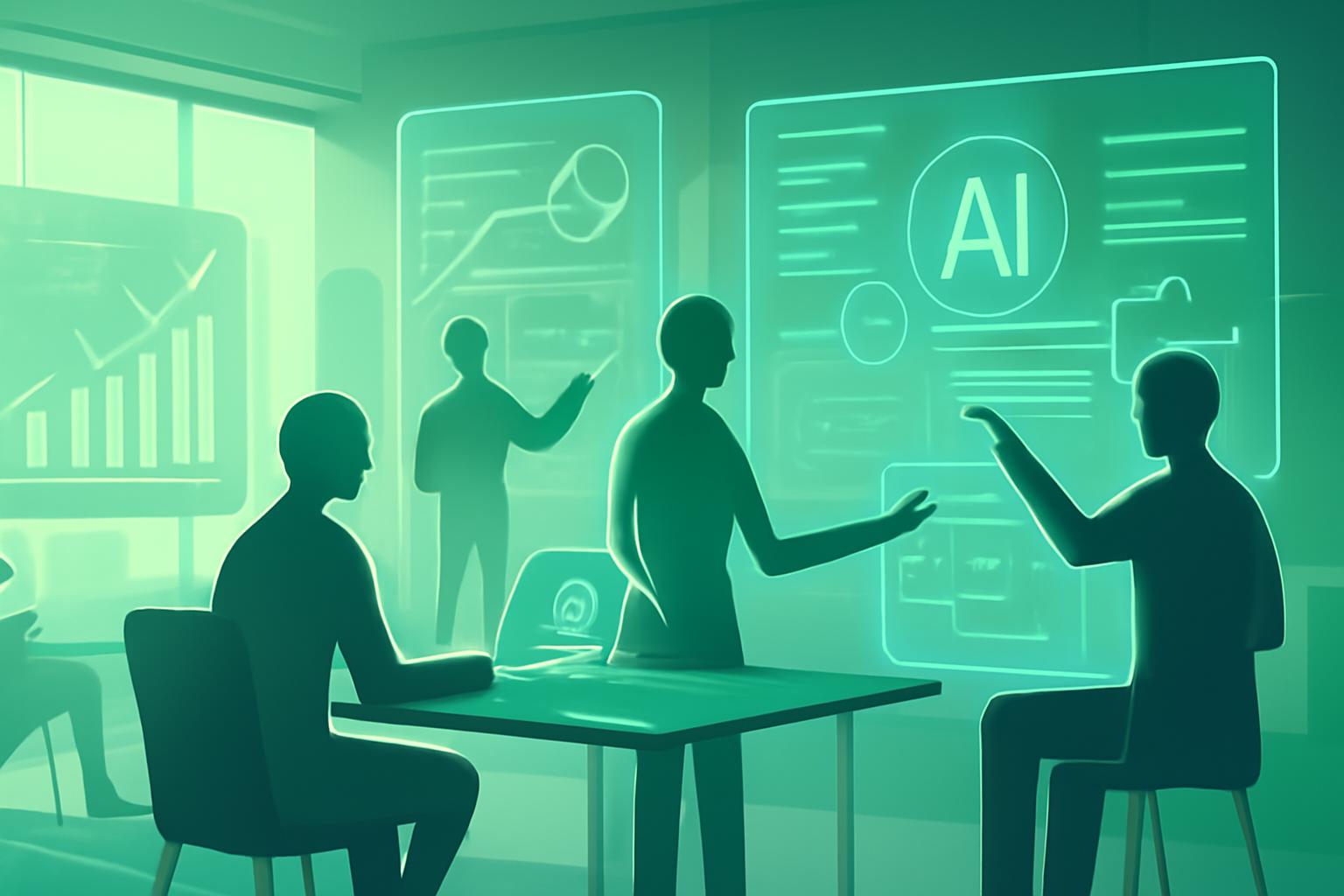OpenAI’s GDPval benchmark offers a valuable early glimpse into AI’s growing capacity to perform economically significant tasks at a level comparable to human professionals. While current assessments remain limited in scope, the rapid performance gains from GPT-4o to GPT-5 underscore the accelerating pace of AI development. !-- wp:paragraph -->
- Opportunities: AI can augment human productivity by automating routine report generation, enabling professionals to focus on complex, value-added activities.
- Risks: Premature expectations of AI fully replacing human roles may overlook the nuanced, interactive nature of many jobs.
- Market Implications: Industries such as finance, healthcare, and government could see significant workflow transformations as AI capabilities mature.
- Benchmark Evolution: Expanding GDPval to include dynamic and collaborative tasks will be critical for accurately assessing AI’s real-world impact.
FinOracleAI — Market View
OpenAI’s GDPval benchmark offers a valuable early glimpse into AI’s growing capacity to perform economically significant tasks at a level comparable to human professionals. While current assessments remain limited in scope, the rapid performance gains from GPT-4o to GPT-5 underscore the accelerating pace of AI development. !-- wp:paragraph -->- Opportunities: AI can augment human productivity by automating routine report generation, enabling professionals to focus on complex, value-added activities.
- Risks: Premature expectations of AI fully replacing human roles may overlook the nuanced, interactive nature of many jobs.
- Market Implications: Industries such as finance, healthcare, and government could see significant workflow transformations as AI capabilities mature.
- Benchmark Evolution: Expanding GDPval to include dynamic and collaborative tasks will be critical for accurately assessing AI’s real-world impact.
Expert Insights on AI’s Impact in the Workplace
“Because the model is getting good at some of these things, people in those jobs can now use the model, increasingly as capabilities get better, to offload some of their work and do potentially higher value things,” said Dr. Aaron Chatterji, OpenAI’s chief economist.
FinOracleAI — Market View
OpenAI’s GDPval benchmark offers a valuable early glimpse into AI’s growing capacity to perform economically significant tasks at a level comparable to human professionals. While current assessments remain limited in scope, the rapid performance gains from GPT-4o to GPT-5 underscore the accelerating pace of AI development. !-- wp:paragraph -->- Opportunities: AI can augment human productivity by automating routine report generation, enabling professionals to focus on complex, value-added activities.
- Risks: Premature expectations of AI fully replacing human roles may overlook the nuanced, interactive nature of many jobs.
- Market Implications: Industries such as finance, healthcare, and government could see significant workflow transformations as AI capabilities mature.
- Benchmark Evolution: Expanding GDPval to include dynamic and collaborative tasks will be critical for accurately assessing AI’s real-world impact.
Expert Insights on AI’s Impact in the Workplace
“Because the model is getting good at some of these things, people in those jobs can now use the model, increasingly as capabilities get better, to offload some of their work and do potentially higher value things,” said Dr. Aaron Chatterji, OpenAI’s chief economist.
FinOracleAI — Market View
OpenAI’s GDPval benchmark offers a valuable early glimpse into AI’s growing capacity to perform economically significant tasks at a level comparable to human professionals. While current assessments remain limited in scope, the rapid performance gains from GPT-4o to GPT-5 underscore the accelerating pace of AI development. !-- wp:paragraph -->- Opportunities: AI can augment human productivity by automating routine report generation, enabling professionals to focus on complex, value-added activities.
- Risks: Premature expectations of AI fully replacing human roles may overlook the nuanced, interactive nature of many jobs.
- Market Implications: Industries such as finance, healthcare, and government could see significant workflow transformations as AI capabilities mature.
- Benchmark Evolution: Expanding GDPval to include dynamic and collaborative tasks will be critical for accurately assessing AI’s real-world impact.
Current Limitations and Plans for Expansion
OpenAI acknowledges that GDPval currently assesses a narrow slice of professional work, primarily focused on producing research reports. Most professionals engage in a broader array of responsibilities, including interactive and dynamic workflows, which are not yet captured by the benchmark. !-- wp:paragraph --> Future iterations of GDPval aim to incorporate a wider variety of industries and more complex task formats to better reflect the multifaceted nature of human jobs. !-- wp:paragraph -->Expert Insights on AI’s Impact in the Workplace
“Because the model is getting good at some of these things, people in those jobs can now use the model, increasingly as capabilities get better, to offload some of their work and do potentially higher value things,” said Dr. Aaron Chatterji, OpenAI’s chief economist.
FinOracleAI — Market View
OpenAI’s GDPval benchmark offers a valuable early glimpse into AI’s growing capacity to perform economically significant tasks at a level comparable to human professionals. While current assessments remain limited in scope, the rapid performance gains from GPT-4o to GPT-5 underscore the accelerating pace of AI development. !-- wp:paragraph -->- Opportunities: AI can augment human productivity by automating routine report generation, enabling professionals to focus on complex, value-added activities.
- Risks: Premature expectations of AI fully replacing human roles may overlook the nuanced, interactive nature of many jobs.
- Market Implications: Industries such as finance, healthcare, and government could see significant workflow transformations as AI capabilities mature.
- Benchmark Evolution: Expanding GDPval to include dynamic and collaborative tasks will be critical for accurately assessing AI’s real-world impact.
Current Limitations and Plans for Expansion
OpenAI acknowledges that GDPval currently assesses a narrow slice of professional work, primarily focused on producing research reports. Most professionals engage in a broader array of responsibilities, including interactive and dynamic workflows, which are not yet captured by the benchmark. !-- wp:paragraph --> Future iterations of GDPval aim to incorporate a wider variety of industries and more complex task formats to better reflect the multifaceted nature of human jobs. !-- wp:paragraph -->Expert Insights on AI’s Impact in the Workplace
“Because the model is getting good at some of these things, people in those jobs can now use the model, increasingly as capabilities get better, to offload some of their work and do potentially higher value things,” said Dr. Aaron Chatterji, OpenAI’s chief economist.
FinOracleAI — Market View
OpenAI’s GDPval benchmark offers a valuable early glimpse into AI’s growing capacity to perform economically significant tasks at a level comparable to human professionals. While current assessments remain limited in scope, the rapid performance gains from GPT-4o to GPT-5 underscore the accelerating pace of AI development. !-- wp:paragraph -->- Opportunities: AI can augment human productivity by automating routine report generation, enabling professionals to focus on complex, value-added activities.
- Risks: Premature expectations of AI fully replacing human roles may overlook the nuanced, interactive nature of many jobs.
- Market Implications: Industries such as finance, healthcare, and government could see significant workflow transformations as AI capabilities mature.
- Benchmark Evolution: Expanding GDPval to include dynamic and collaborative tasks will be critical for accurately assessing AI’s real-world impact.
GPT-5-High Demonstrates Significant Gains Over Previous Models
The enhanced GPT-5-high model, benefitting from additional computational resources, achieved a win or tie rate of 40.6% against human experts across the evaluated tasks. This represents a nearly threefold improvement compared to OpenAI’s earlier GPT-4o model, which scored 13.7% approximately 15 months prior. !-- wp:paragraph --> Anthropic’s Claude Opus 4.1 model performed slightly better, with a 49% win or tie rate. OpenAI notes that Claude’s higher score may partially result from its ability to generate visually appealing graphics, which can influence evaluators’ judgments. !-- wp:paragraph -->Current Limitations and Plans for Expansion
OpenAI acknowledges that GDPval currently assesses a narrow slice of professional work, primarily focused on producing research reports. Most professionals engage in a broader array of responsibilities, including interactive and dynamic workflows, which are not yet captured by the benchmark. !-- wp:paragraph --> Future iterations of GDPval aim to incorporate a wider variety of industries and more complex task formats to better reflect the multifaceted nature of human jobs. !-- wp:paragraph -->Expert Insights on AI’s Impact in the Workplace
“Because the model is getting good at some of these things, people in those jobs can now use the model, increasingly as capabilities get better, to offload some of their work and do potentially higher value things,” said Dr. Aaron Chatterji, OpenAI’s chief economist.
FinOracleAI — Market View
OpenAI’s GDPval benchmark offers a valuable early glimpse into AI’s growing capacity to perform economically significant tasks at a level comparable to human professionals. While current assessments remain limited in scope, the rapid performance gains from GPT-4o to GPT-5 underscore the accelerating pace of AI development. !-- wp:paragraph -->- Opportunities: AI can augment human productivity by automating routine report generation, enabling professionals to focus on complex, value-added activities.
- Risks: Premature expectations of AI fully replacing human roles may overlook the nuanced, interactive nature of many jobs.
- Market Implications: Industries such as finance, healthcare, and government could see significant workflow transformations as AI capabilities mature.
- Benchmark Evolution: Expanding GDPval to include dynamic and collaborative tasks will be critical for accurately assessing AI’s real-world impact.
GPT-5-High Demonstrates Significant Gains Over Previous Models
The enhanced GPT-5-high model, benefitting from additional computational resources, achieved a win or tie rate of 40.6% against human experts across the evaluated tasks. This represents a nearly threefold improvement compared to OpenAI’s earlier GPT-4o model, which scored 13.7% approximately 15 months prior. !-- wp:paragraph --> Anthropic’s Claude Opus 4.1 model performed slightly better, with a 49% win or tie rate. OpenAI notes that Claude’s higher score may partially result from its ability to generate visually appealing graphics, which can influence evaluators’ judgments. !-- wp:paragraph -->Current Limitations and Plans for Expansion
OpenAI acknowledges that GDPval currently assesses a narrow slice of professional work, primarily focused on producing research reports. Most professionals engage in a broader array of responsibilities, including interactive and dynamic workflows, which are not yet captured by the benchmark. !-- wp:paragraph --> Future iterations of GDPval aim to incorporate a wider variety of industries and more complex task formats to better reflect the multifaceted nature of human jobs. !-- wp:paragraph -->Expert Insights on AI’s Impact in the Workplace
“Because the model is getting good at some of these things, people in those jobs can now use the model, increasingly as capabilities get better, to offload some of their work and do potentially higher value things,” said Dr. Aaron Chatterji, OpenAI’s chief economist.
FinOracleAI — Market View
OpenAI’s GDPval benchmark offers a valuable early glimpse into AI’s growing capacity to perform economically significant tasks at a level comparable to human professionals. While current assessments remain limited in scope, the rapid performance gains from GPT-4o to GPT-5 underscore the accelerating pace of AI development. !-- wp:paragraph -->- Opportunities: AI can augment human productivity by automating routine report generation, enabling professionals to focus on complex, value-added activities.
- Risks: Premature expectations of AI fully replacing human roles may overlook the nuanced, interactive nature of many jobs.
- Market Implications: Industries such as finance, healthcare, and government could see significant workflow transformations as AI capabilities mature.
- Benchmark Evolution: Expanding GDPval to include dynamic and collaborative tasks will be critical for accurately assessing AI’s real-world impact.
GDPval: Testing AI Across Nine Major Industries
GDPval evaluates AI performance in 44 distinct occupations spanning nine industries that collectively drive the majority of the U.S. gross domestic product. These sectors include healthcare, finance, manufacturing, government, and more. The benchmark specifically measures AI’s ability to produce professional-level reports and analyses comparable to those generated by experienced human experts. !-- wp:paragraph --> For instance, investment bankers participating in the evaluation compared AI-generated competitor landscape reports on the last-mile delivery market to those composed by their peers, selecting the superior output. OpenAI aggregates these comparisons to calculate an AI model’s overall win rate against human professionals. !-- wp:paragraph -->GPT-5-High Demonstrates Significant Gains Over Previous Models
The enhanced GPT-5-high model, benefitting from additional computational resources, achieved a win or tie rate of 40.6% against human experts across the evaluated tasks. This represents a nearly threefold improvement compared to OpenAI’s earlier GPT-4o model, which scored 13.7% approximately 15 months prior. !-- wp:paragraph --> Anthropic’s Claude Opus 4.1 model performed slightly better, with a 49% win or tie rate. OpenAI notes that Claude’s higher score may partially result from its ability to generate visually appealing graphics, which can influence evaluators’ judgments. !-- wp:paragraph -->Current Limitations and Plans for Expansion
OpenAI acknowledges that GDPval currently assesses a narrow slice of professional work, primarily focused on producing research reports. Most professionals engage in a broader array of responsibilities, including interactive and dynamic workflows, which are not yet captured by the benchmark. !-- wp:paragraph --> Future iterations of GDPval aim to incorporate a wider variety of industries and more complex task formats to better reflect the multifaceted nature of human jobs. !-- wp:paragraph -->Expert Insights on AI’s Impact in the Workplace
“Because the model is getting good at some of these things, people in those jobs can now use the model, increasingly as capabilities get better, to offload some of their work and do potentially higher value things,” said Dr. Aaron Chatterji, OpenAI’s chief economist.
FinOracleAI — Market View
OpenAI’s GDPval benchmark offers a valuable early glimpse into AI’s growing capacity to perform economically significant tasks at a level comparable to human professionals. While current assessments remain limited in scope, the rapid performance gains from GPT-4o to GPT-5 underscore the accelerating pace of AI development. !-- wp:paragraph -->- Opportunities: AI can augment human productivity by automating routine report generation, enabling professionals to focus on complex, value-added activities.
- Risks: Premature expectations of AI fully replacing human roles may overlook the nuanced, interactive nature of many jobs.
- Market Implications: Industries such as finance, healthcare, and government could see significant workflow transformations as AI capabilities mature.
- Benchmark Evolution: Expanding GDPval to include dynamic and collaborative tasks will be critical for accurately assessing AI’s real-world impact.
OpenAI’s GPT-5 Models Human Expertise in Core Economic Sectors
OpenAI has unveiled a new benchmark, GDPval, designed to assess how closely its AI models replicate or exceed the quality of work produced by human professionals across a broad range of industries and occupations. This initiative marks a significant step in OpenAI’s pursuit of artificial general intelligence (AGI), measuring AI’s ability to perform economically valuable tasks at a human level. !-- wp:paragraph -->GDPval: Testing AI Across Nine Major Industries
GDPval evaluates AI performance in 44 distinct occupations spanning nine industries that collectively drive the majority of the U.S. gross domestic product. These sectors include healthcare, finance, manufacturing, government, and more. The benchmark specifically measures AI’s ability to produce professional-level reports and analyses comparable to those generated by experienced human experts. !-- wp:paragraph --> For instance, investment bankers participating in the evaluation compared AI-generated competitor landscape reports on the last-mile delivery market to those composed by their peers, selecting the superior output. OpenAI aggregates these comparisons to calculate an AI model’s overall win rate against human professionals. !-- wp:paragraph -->GPT-5-High Demonstrates Significant Gains Over Previous Models
The enhanced GPT-5-high model, benefitting from additional computational resources, achieved a win or tie rate of 40.6% against human experts across the evaluated tasks. This represents a nearly threefold improvement compared to OpenAI’s earlier GPT-4o model, which scored 13.7% approximately 15 months prior. !-- wp:paragraph --> Anthropic’s Claude Opus 4.1 model performed slightly better, with a 49% win or tie rate. OpenAI notes that Claude’s higher score may partially result from its ability to generate visually appealing graphics, which can influence evaluators’ judgments. !-- wp:paragraph -->Current Limitations and Plans for Expansion
OpenAI acknowledges that GDPval currently assesses a narrow slice of professional work, primarily focused on producing research reports. Most professionals engage in a broader array of responsibilities, including interactive and dynamic workflows, which are not yet captured by the benchmark. !-- wp:paragraph --> Future iterations of GDPval aim to incorporate a wider variety of industries and more complex task formats to better reflect the multifaceted nature of human jobs. !-- wp:paragraph -->Expert Insights on AI’s Impact in the Workplace
“Because the model is getting good at some of these things, people in those jobs can now use the model, increasingly as capabilities get better, to offload some of their work and do potentially higher value things,” said Dr. Aaron Chatterji, OpenAI’s chief economist.
FinOracleAI — Market View
OpenAI’s GDPval benchmark offers a valuable early glimpse into AI’s growing capacity to perform economically significant tasks at a level comparable to human professionals. While current assessments remain limited in scope, the rapid performance gains from GPT-4o to GPT-5 underscore the accelerating pace of AI development. !-- wp:paragraph -->- Opportunities: AI can augment human productivity by automating routine report generation, enabling professionals to focus on complex, value-added activities.
- Risks: Premature expectations of AI fully replacing human roles may overlook the nuanced, interactive nature of many jobs.
- Market Implications: Industries such as finance, healthcare, and government could see significant workflow transformations as AI capabilities mature.
- Benchmark Evolution: Expanding GDPval to include dynamic and collaborative tasks will be critical for accurately assessing AI’s real-world impact.













